Introduction
Tourism in Northern Ireland accounted for £2.3 billion or 5% of the region’s Gross Value Added in 2019. The sector supported 70,200 jobs in Northern Ireland in 2022. The COVID-19 pandemic and resulting lockdowns hit the sector hard. In April 2022, the tourism industry body – Northern Ireland Tourism Alliance (NITA) – estimated that the pandemic had resulted in a loss of £1bn in tourist expenditure in Northern Ireland.
This blog article sets out the latest tourism performance data published by the Northern Ireland Statistics and Research Agency (NISRA), to examine how the sector has recovered post-COVID. It also provides an update on a tourism strategy for Northern Ireland, as well as providing a summary of some of the challenges and opportunities identified during the 2023-24 session of the Northern Ireland Assembly, to make progress in this sector.
Tourism performance
The coronavirus pandemic interrupted the collection and publication of tourism data in Northern Ireland. Data collection activities were paused in 2020, and did not resume until summer 2022. NISRA published updated annual data on Northern Ireland’s tourism performance this September. That dataset covers the years 2013 to 2019, and 2023. No data is available for the 2020 to 2022 period, leaving a gap in tourism performance data.
Trips within Northern Ireland
From 2013 to 2019 the number of tourism trips within Northern Ireland increased, with total trips from 4.1 million to 5.3 million (Figure 1, below). By 2023, the number of trips in Northern Ireland reached 5.4 million; surpassing pre-COVID levels. This increase was primarily driven by visitors from the Republic of Ireland, who made 1.31 million trips in 2023, compared to 755,795 in 2019. Not all markets, however, had recovered to 2019 levels by 2023. In particular, the number of trips made by visitors from the ‘rest of the world’ decreased from 783,499 in 2019, to 505,501 in 2023.
Figure 1: Total tourism trips to Northern Ireland 2013 to 2023
In 2023 the total number of tourism trips to Northern Ireland was above pre-COVID levels
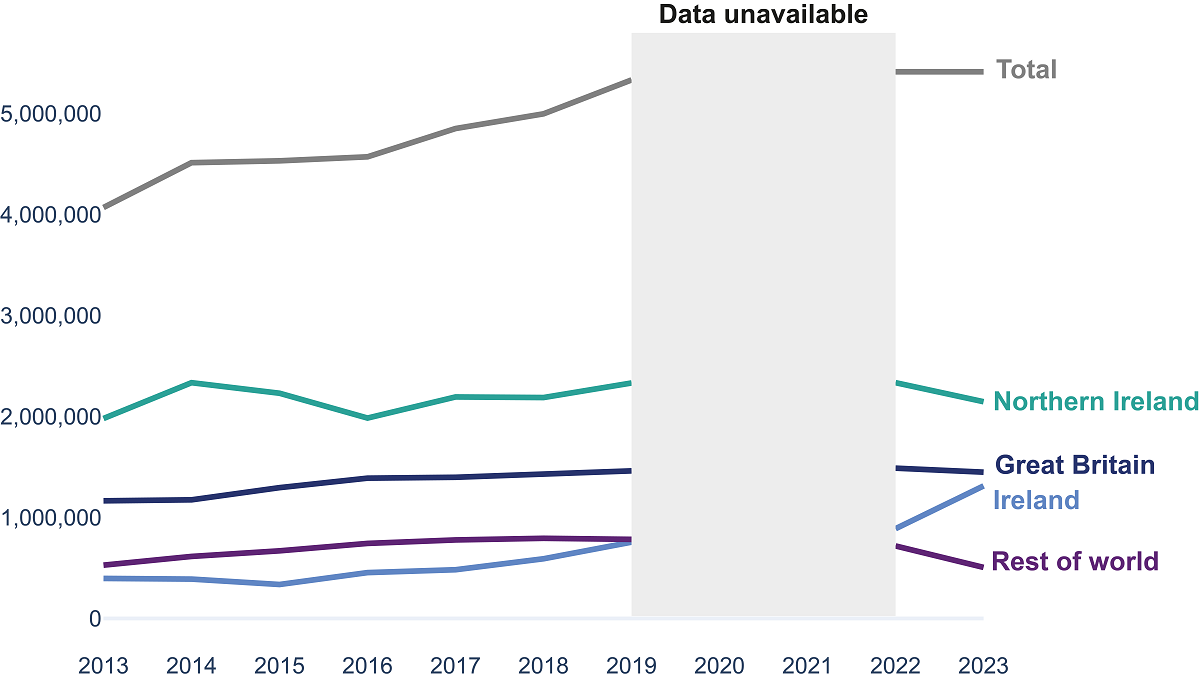
Nights spent in Northern Ireland
Nights spent in Northern Ireland increased from 14.4 million in 2013, to 16.6 million in 2019 (Figure 2, below). As of 2023, the number of nights spent in Northern Ireland had returned to pre-COVID levels, with visitors spending 16.6 million nights in the region in that year. Whereas the Great Britain and Republic of Ireland markets recovered from the COVID-19 pandemic more quickly, with the number of nights spent by visitors from both regions surpassing their 2019 levels in 2023. As of 2023, the number of nights spent by visitors from the rest of the world and domestic tourists was below the pre-COVID level.
Figure 2: Total tourism nights in Northern Ireland 2013 to 2023
In 2023 the total number of tourism nights spent in Northern Ireland have recovered to pre-COVID levels
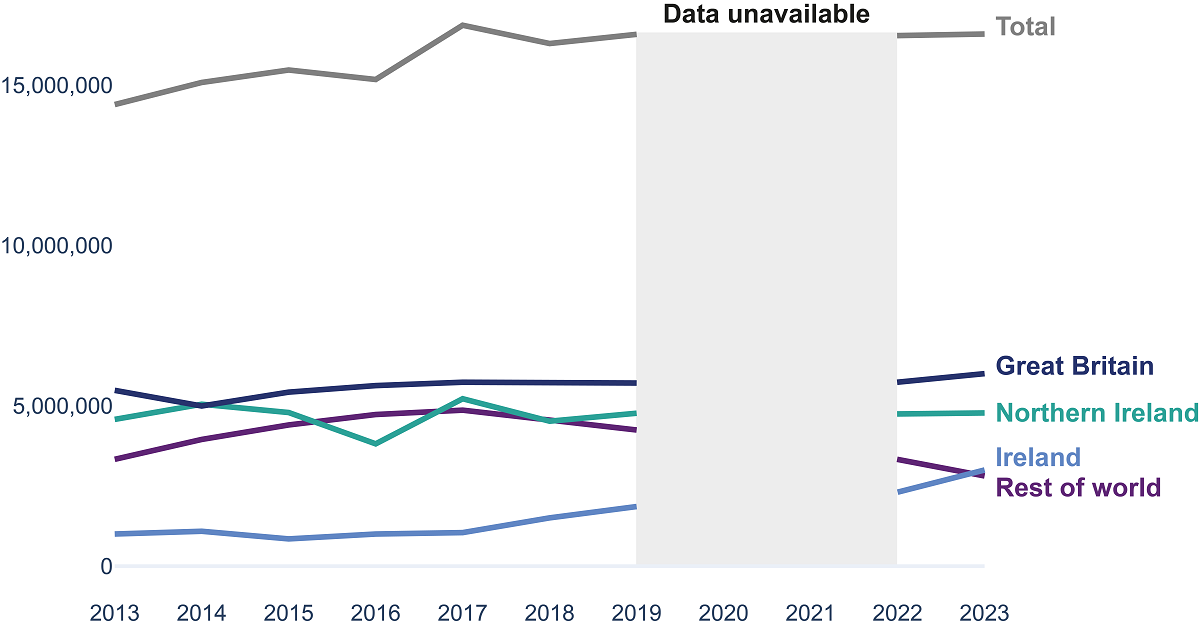
Expenditure in Northern Ireland
Tourism expenditure in Northern Ireland increased from £715 million in 2013, to £1 billion in 2019; and by 2023 to £1.2 billion. The noted post-COVID recovery was driven by visitors from Great Britain and the Republic of Ireland. Expenditure by tourists from Great Britain increased from £369 million in 2019, to £466 million in 2023. Expenditure by Republic of Ireland visitors increased from 142 million in 2019, to £268 million in 2023. As of 2023, expenditure by the rest of the world and domestic tourists in Northern Ireland had not returned to pre-COVID levels.
Figure 3: Total tourism expenditure in Northern Ireland 2013 to 2023
In 2023 the total amount of tourism expenditure in Northern Ireland was above pre-COVID levels
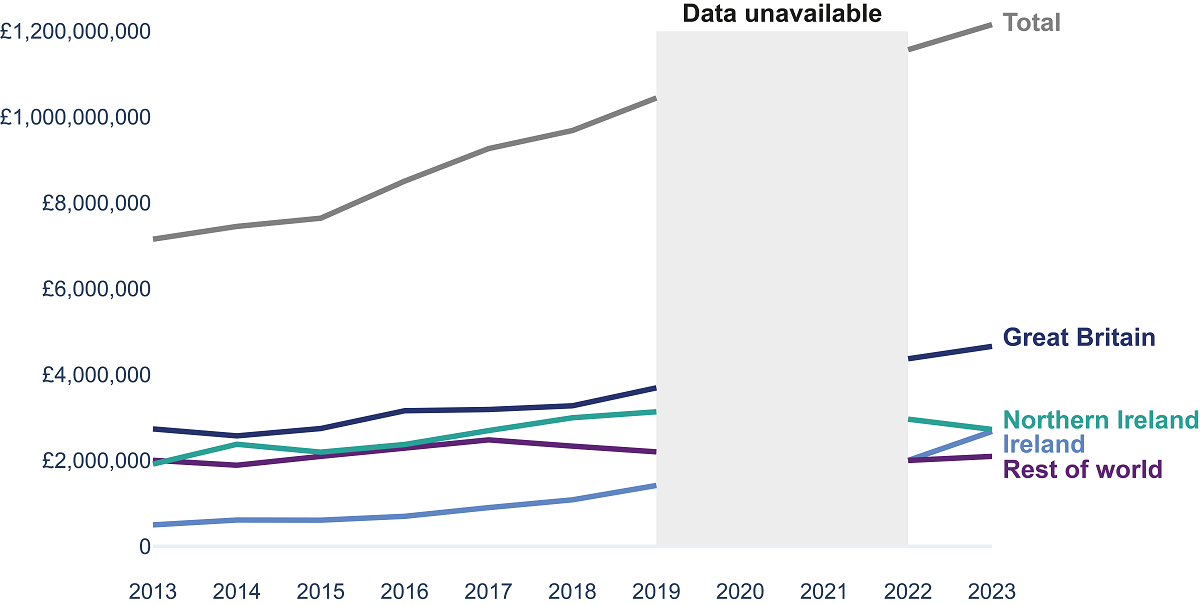
Average number of nights per trip
Overall, visitors to Northern Ireland spent an average of 3.11 nights in Northern Ireland in 2019; down slightly from 3.54 in 2013 (Figure 4, below). In 2023, the average number of nights spent had fallen to 3.07. Visitors from the rest of the world tended to spend the longest in Northern Ireland on their visits. As of 2023, such visitors spent 5.56 nights in Northern Ireland per trip; up from 5.42 in 2019. Domestic tourists spent the shortest time on their visits; spending 2.23 nights per trip in 2023. Visitors from Great Britain spent 4.14 nights per trip in 2023; while visitors from the Republic of Ireland spent 2.28 nights per trip.
Figure 4: Average number of nights per trip in Northern Ireland 2013 to 2023
Rest of the world visitors tend to spend more nights per trip in Northern Ireland than other visitors
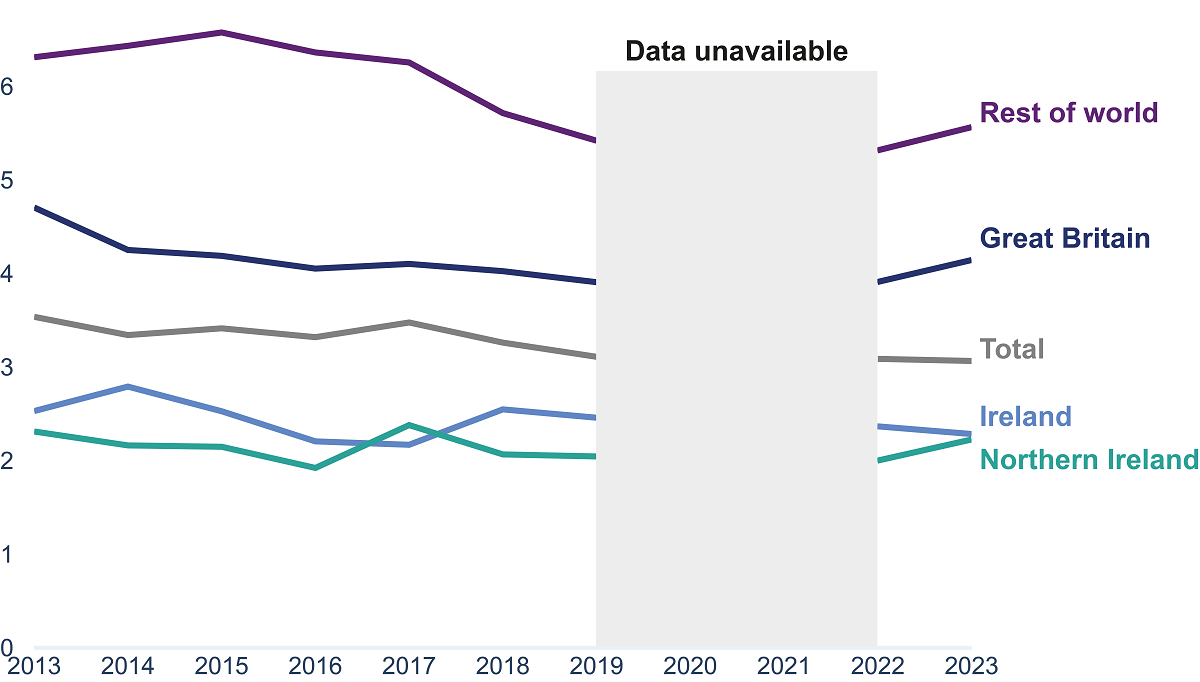
Average expenditure per trip
In 2013, visitors to Northern Ireland spent £175.70 per trip on average. By 2019, this had increased to £195.80 per trip. In 2023, it had risen to £224.44. Visitors from the rest of the world spend the most on average per trip in Northern Ireland. In 2023, those visitors spent an average of £414.33 per trip; up from £280.80 in 2019. Domestic tourists spent the least per trip. In 2023, domestic tourists spent £128.81 per trip on average; down from £134.30 in 2019. In 2023, the average per trips spend of tourists from Great Britain (£321.40 per trip) and the Republic of Ireland (£203.93 per trip) was above pre-COVID levels.
Figure 5: Average expenditure per trip in Northern Ireland 2013 to 2023
Rest of the world visitors tend to spend more money per trip in Northern Ireland than other visitors
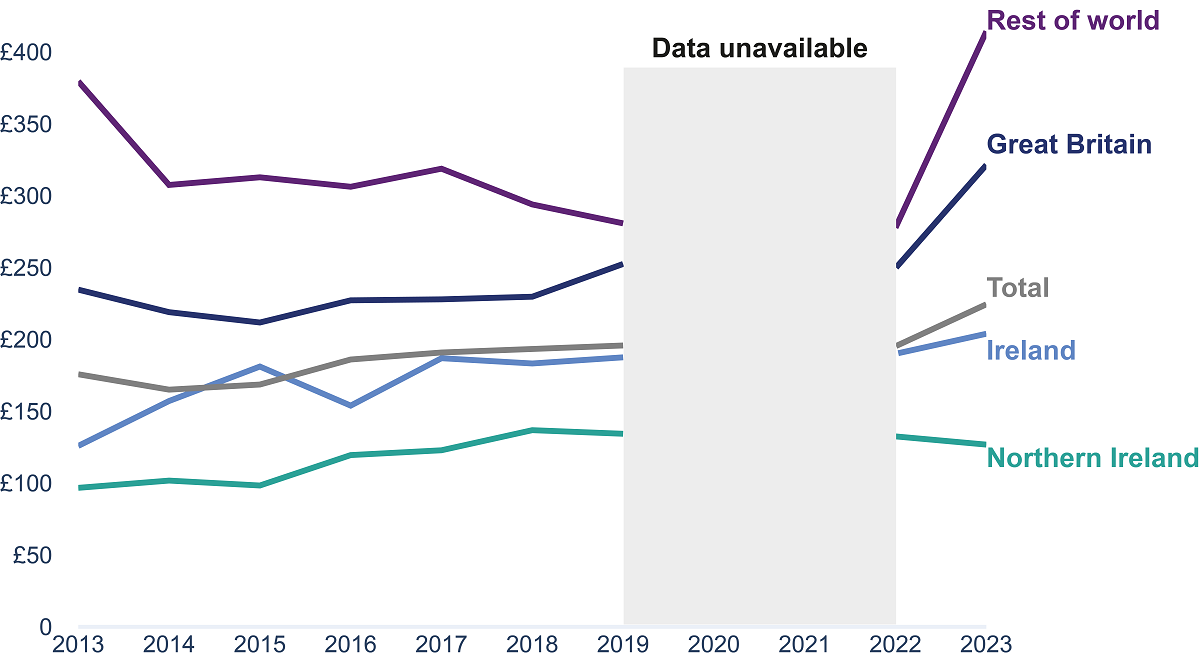
Tourism Strategy
Interrupted devolution in Northern Ireland appears to have adversely impacted the implementation of an overarching Tourism Strategy for the region for many years, arguably leaving the tourism sector to operate without shared vision. A draft Strategy was produced in 2010. That Strategy was due to come into effect from 1 April 2011, but was not agreed by the Executive due to a new review of tourism in Northern Ireland. That review, known as the Hunter Review, was published in 2014. The Review noted that although the absence of strategy had not prevented ‘substantial developments’, it had ‘…inhibited the development of collaborative partnerships’ and ’caused a degree of confusion in the industry…’. It therefore recommended that the Northern Ireland Executive publish an updated tourism strategy.
Nearly a decade later, on 6 November 2023, the Department for the Economy (DfE) launched a consultation on a new draft Tourism Strategy for Northern Ireland: 10-year plan (the draft Strategy). The strategic aim of the draft Strategy was to ‘…increase the value of tourism to the Northern Ireland economy by 50-75% compared to 2019…’. The draft Strategy identified Northern Ireland, Great Britain, the Republic of Ireland and North American as the four countries that the DfE will focus on when seeking to achieve that aim.
Consultation on the draft Tourism Strategy closed on 12 January 2024. In response to the consultation, the Minister for the Economy announced his intention to bring forward a Tourism Action Plan. That Plan will be co-designed by a Tourism Partnership Board (TPB), which will comprise representatives from tourism and hospitality, Executive Departments and local government. In evidence to the Assembly’s Economy Committee on 26 June 2024, the Minister noted the appointments of the TPB Chair and its members. At the time of writing, it remains to be seen as to what next will follow from the TPB, and the Minister in relation to his Tourism Action Plan.
Potential opportunities and challenges
Perhaps both will revisit the range of tourism opportunities and challenges that arose during the previous Northern Ireland Assembly session (2023/24), such as those set out in the following paragraphs.
Air connectivity
In March 2024, the DfE published a study on Air connectivity to support inbound tourism and business growth. That study found that Northern Ireland had ‘…good demand for air travel…’ and that it was ‘…very well connected in terms of both domestic destinations and frequencies…’. With regard to international flights, the report found Northern Ireland was ‘…lacking the frequency of flights to major hubs such as Amsterdam and Frankfurt…’ and ‘…the range of destinations (in terms of world cities) that can be reached via a 1-stop connection are good, but there is room for improvement…’.
The report concluded that there was a ‘strong case’ for the Northern Ireland Executive to support additional routes to North America, France, Germany and Denmark.
The Electronic Travel Authorisation (ETA)
The Nationality and Borders Act 2022 introduced an ETA that will require citizens of countries who do not currently need a visa when coming to the United Kingdom, to apply for an ETA prior to travelling to the United Kingdom. The ETA is being implemented in a staged roll-out. As of 25 October 2023, the process was rolled-out for Qatari nationals. It was further rolled out to nationals of Bahrain, Jordan, Kuwait, Oman, United Arab Emirates and Saudi Arabia on 1 February 2024. The previous United Kingdom Government aimed to extend the requirement for an ETA to all ‘non-visa nationalities by the end of 2024’. It is not clear at this time if that remains the target under the current United Kingdom Government.
From a Northern Ireland perspective, British and Irish nationals, and eligible residents of the Republic of Ireland will not require an ETA. Tourists visiting Northern Ireland from ‘non-visa’ countries, including those who enter Northern Ireland from the Republic of Ireland will require an ETA.
The tourism industry body NITA has raised concerns about the impact of the ETA on the sector. NITA unsuccessfully lobbied for an ‘…exemption package for up to 5-7 days for tourists travelling to Northern Ireland through the Republic of Ireland…’. The DfE has also raised concerns, noting that 70% of rest of the world visitors to Northern Ireland have historically arrived in the Republic Ireland, before travelling to Northern Ireland.
The Northern Ireland Minister for the Economy noted on 4 June 2024 that he had written to the Home Office in April 2024 seeking a meeting to discuss concerns about the ETA. As of 4 June 2024, no meeting had taken place. On the same date, the Minister for the Economy stated his intention to write again to the Home Office after the July 2024 general election. No further updates were available at the time of writing.
Value Added Tax (VAT)
In Northern Ireland, like the rest of the United Kingdom, the VAT rate for the hospitality industry is set at 20%. In the Republic of Ireland, a rate of 13.5% is applied to the sector. A motion concerning VAT and the tourism sector – ‘Devolution of VAT for Hospitality’ – was debated in the Northern Ireland Assembly on 13 May 2024. It called on the Minister of Finance and the Minster for the Economy to ‘…bring forward a package of costed interventions to support the sector, including options for the devolution of VAT for hospitality fortify this important sector and create the conditions for jobs growth…’. And following an Assembly vote, the motion was carried.
Subsequently, on 10 June 2024, the Minister of the Economy stated that the Minister for Finance had raised the issue of “negative impacts on hospitality of high levels of VAT” with the Treasury. The Minister for the Economy also stated that he would “…continue to engage with the Minister for Finance to push for reform of the VAT rate for our hospitality industry…”.
Cross-border brand linkages
The Republic of Ireland’s tourism agency – Fáilte Ireland – has introduced a number of successful tourism brands in recent years. The Wild Atlantic Way was introduced in 2014. According to Fáilte Ireland, an estimated 2 million more tourists visited the Wild Atlantic Way in 2023, compared to 2013. A second brand ‘Ireland’s Ancient East’ was launched in 2015. Fáilte Ireland has estimated that as of 2019, the brand was worth €1.7 billion to the regional economy, and had supported 55,000 jobs.
At the annual Tourism Northern Ireland Conference in April 2023, the Minister for the Economy set out an outline of the Department’s plans to growth tourism in Northern Ireland. That outlined plans to discuss the potential of extending Fáilte Ireland’s tourism brands to Northern Ireland. Subsequently, in evidence to the Economy Committee on 26 June 2024 the Minister stated that agreement had been reached at a North/South Ministerial Council, to form a group consisting of the three tourism agencies on the island – Tourism Northern Ireland, Tourism Ireland and Fáilte Ireland – as well as the Department for the Economy and its counterpart in the Republic of Ireland, the Department of Tourism, Culture, Arts, Gaeltacht, Sport and Media. The group will have a remit to discuss a range of topics, including marking and branding.
Conclusion
The latest data suggests that the Northern Ireland tourism industry has begun to recover from the effects of the COVID-19 pandemic. Tourism to the region from rest of the world has not, however, returned to pre-pandemic levels.
Looking forward, a range of opportunities and challenges were identified during the previous session of the Northern Ireland Assembly. As the Assembly embarks on a new session, its Members await the forthcoming Tourism Action Plan, currently being developed by the newly constituted Tourism Partnership Board. Will the Plan address the noted challenges and maximise stated opportunities?


